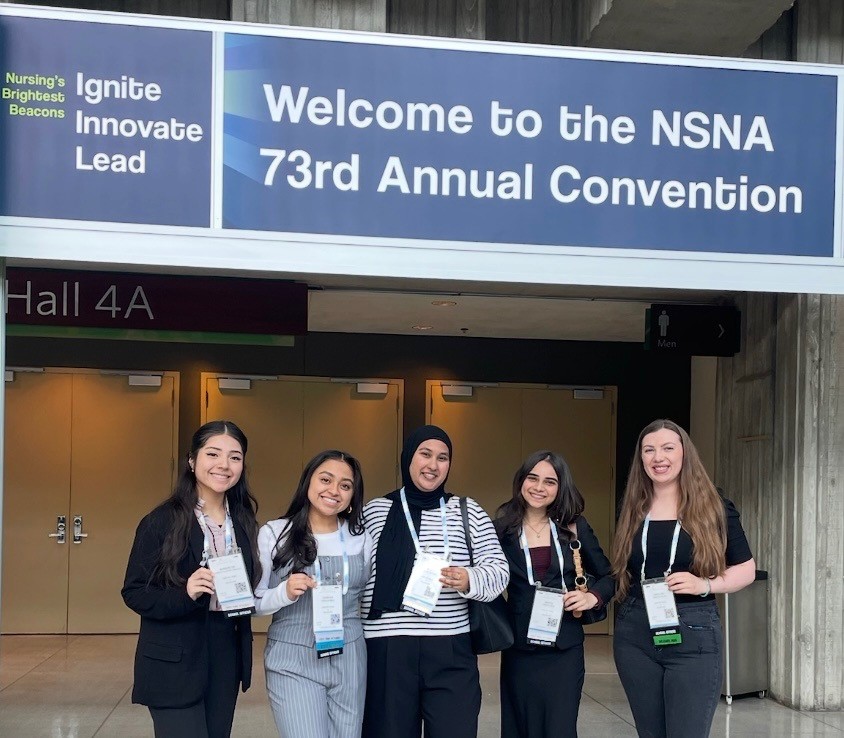I’ve always been drawn to the dual role of advocacy in nursing. On one hand, it means seeking to understand patients and standing up for their well-being at the bedside, and on the other, it involves using those firsthand experiences to influence healthcare systems and policies. That broader vision of nursing inspired me to attend the 73rd Annual National Student Nurses’ Association (NSNA) Convention in Seattle, WA. There, I had the unique opportunity to not only represent the University of Texas at Arlington as a delegate, but to also approach the four day event through the lens of a policy and ethics intern for the American Nurses Association (ANA).
The NSNA hosts a network of over 50,000 members to foster professional development opportunities for nursing students. Members automatically gain admission to the NSNA by joining their school or state chapter affiliates; for example, my membership dues for the Arlington Nursing Students’ Association included access to the Texas Student Nurses’ Association and the NSNA. At the convention, students attended focus sessions on topics ranging from climate change and public health to medical malpractice. Dozens of professional nursing organizations—including ANA—tabled at the Exhibit Hall, where students gained firsthand access to study tools, nurse advocacy groups, nursing school admissions resources, and hospital employers. Several students ran for NSNA officer positions and took advantage of the convention to platform their campaigns in time for elections.
As a first-time attendee, my favorite part of the convention was the House of Delegates business meetings, where delegates voted on resolutions to shape nursing education and practice. Resolution authors representing their state and local chapters brought their proposals to the floor, and delegates engaged in pro/con style debates to offer new perspectives on each topic. Some resolutions, such as increasing food label literacy and expanding code lavender in hospitals passed unanimously, while other topics like maintaining Diversity, Equity, Inclusion, Belonging, and Accessibility legislation and preserving fluoride in drinking water garnered longer disputes.
The sheer range of perspectives presented was fascinating to me because they proved that nurses represent an array of lived experiences. I quickly learned that these weren’t only nursing students—they were also patients, immigrants, entrepreneurs, and parents. For example, a student from Arizona proposed that school nurses ought to be pre-hospital and trauma certified to make schools safer in the event of mass casualties and natural disasters. She shared that as a mother, she created the resolution out of concern for her school-aged children, effectively bridging her roles as a parent, advocate, and future nurse.

This delegate’s resolution, among several others, informed me of issues I had never considered before stepping into the convention. We often picture “advocacy” as wielding a bullhorn at the picket line or speaking to elected officials. While these ideas can be true, there’s a quieter, lesser known side of advocacy that involves absorbing stories from the people we serve, and approaching each of their experiences with curiosity and humility. Interestingly, this practice closely mirrors what nurses are already trained to do with their patients; future nurses are building the skillsets to listen actively and compassionately, collaborate across differences, and work toward shared solutions.
Spaces like the NSNA Convention show nursing students how far these skills can reach beyond the bedside. In a climate where less than 10 percent of nurses are estimated to be involved in professional organizations and advocacy efforts, the NSNA Convention offers future nurses the vital opportunity to remain engaged and to see the impact of their voices firsthand. Listening to each resolution made it clear how much work lies ahead of us—but it also left me inspired by the knowledge that, as a future nurse, I have the power to help advance the nursing profession and its policies.
The delegation clashed over different priorities at times, but they stood united in one idea: nurses should be heard, and they are qualified to enact change. Ryan Barrett, the newly-elected 2025-2026 NSNA President, captured this best in his acceptance speech:

“There’s an old saying in advocacy: ‘If you’re not at the table, you’re on the menu.’ But we have a bolder vision. We’re not just pulling up a chair – we’re building a bigger table. A table where every nursing student’s voice echoes through the halls and where decisions on the future of the nursing profession are made. A table where the future of healthcare is shaped by those who deliver it.”
To join the NSNA and learn about all the resources it offers to nursing students, check your school’s constituency status and review the organization’s membership brochure.

